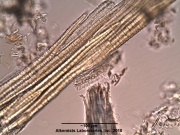| "The Oregon grape is a tall shrub, about six to seven feet high,
with evergreen, coriaceous, bright and shining leaves, and having numerous small, yellowish-green flowers in the early Spring, and later clusters of purple berries containing an acid pulp.
The root, which was formerly official, occurs in pieces about a foot long, one-fourth of an inch thick, of a brownish exterior, but yellowish within, yielding a bright lemon-colored bitter powder. The rhizome was officially described as l( in mere or less knotty irregular pieces of varying length and from 3 to 20 mm. in diameter; bark from 1/2 to 2 mm. thick; wood yellowish, distinctly radiate with narrow medullary rays, hard and tough; rhizome with a small pith [...] Pieces without the bark should be rejected." U. S. VIII.
The N. F. IV recognizes, under the title Berberis, "the rhizome and roots of species of the section Odostemon Rafinesque, of the genus Berberis." This section corresponds to the genus Mahonia of Nuttall, and includes B. Aquifolium and B. Nervosa.
"Cylindrical, more or less knotty, strongly branched, usually cut into pieces of varying length and up to 45 mm. in diameter; externally light yellowish-brown, longitudinally wrinkled and short scaly; fracture hard and tough; bark 1 mm. in thickness, easily separable into layers; wood yellow, the color more pronounced upon wetting, distinctly radiate, and showing rings of growth; pith of rhizome small, sometimes ex-central. [...] The powder is yellowish-brown; composed chiefly of fragments of wood fibers associated with a few tracheae and medullary rays; wood fibers yellowish, scarcely giving any reaction with phloroglucinol T.S. and hydrochloric acid, and with large, simple, transverse pores; trachea chiefly with bordered pores, occasionally reticulate; medullary rays one to twelve cells wide, and in very long rows; starch grains simple or two- to three-compound, the individual grains being irregularly spherical, from 0.003 to 0.01 mm. in diameter, and occasionally larger. " N.F.
Source: United States Dispensatory (1918) [2]
|
|
|

